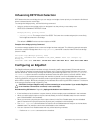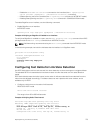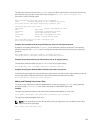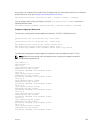
Role Modes
netoperator
netadmin Exec Config Interface Router IP Route-map Protocol MAC
secadmin Exec Config Line
sysadmin Exec Config Interface Line Router IP Route-map Protocol MAC
User Roles
This section describes how to create a new user role and configure command permissions and contains
the following topics.
• Creating a New User Role
• Modifying Command Permissions for Roles
• Adding and Deleting Users from a Role
Creating a New User Role
Instead of using the system defined user roles, you can create a new user role that best matches your
organization. When you create a new user role, you can first inherit permissions from one of the system
defined roles. Otherwise you would have to create a user role’s command permissions from scratch. You
then restrict commands or add commands to that role. For more information about this topic, see
Modifying Command Permissions for Roles.
NOTE: You can change user role permissions on system pre-defined user roles or user-defined user
roles.
Important Points to Remember
Consider the following when creating a user role:
• Only the system administrator and user-defined roles inherited from the system administrator can
create roles and user names. Only the system administrator, security administrator, and roles inherited
from these can use the "role" command to modify command permissions. The security administrator
and roles inherited by security administrator can only modify permissions for commands they already
have access to.
• Make sure you select the correct role you want to inherit.
• If you inherit a user role, you cannot modify or delete the inheritance. If you want to change or
remove the inheritance, delete the user role and create it again. If the user role is in use, you cannot
delete the user role.
1. Create a new user role
CONFIGURATION mode
userrole name [inherit existing-role-name]
2. Verify that the new user role has inherited the security administrator permissions.
Dell(conf)#do show userroles
EXEC Privilege mode
3. After you create a user role, configure permissions for the new user role. See Modifying Command
Permissions for Roles.
780
Security


















